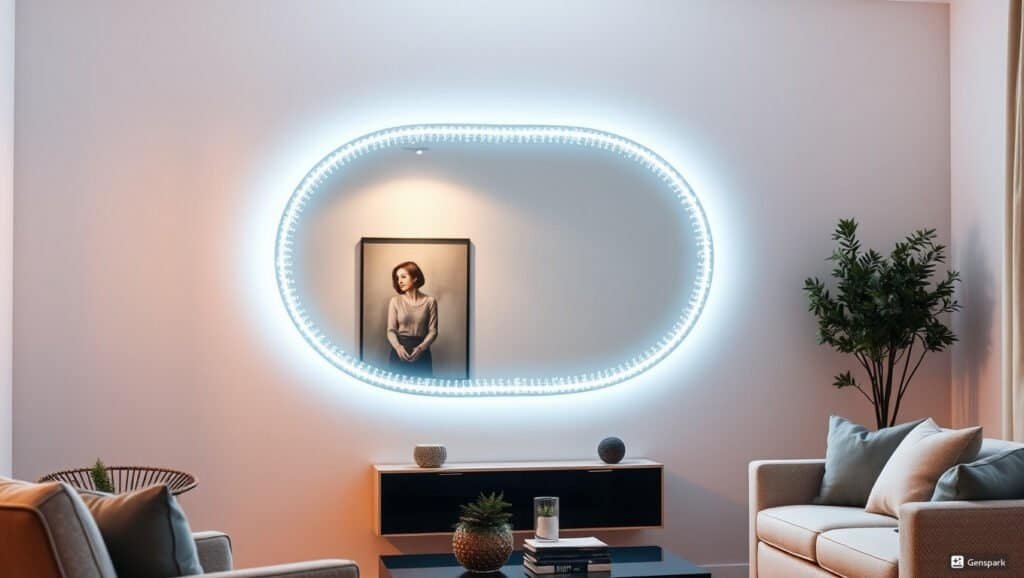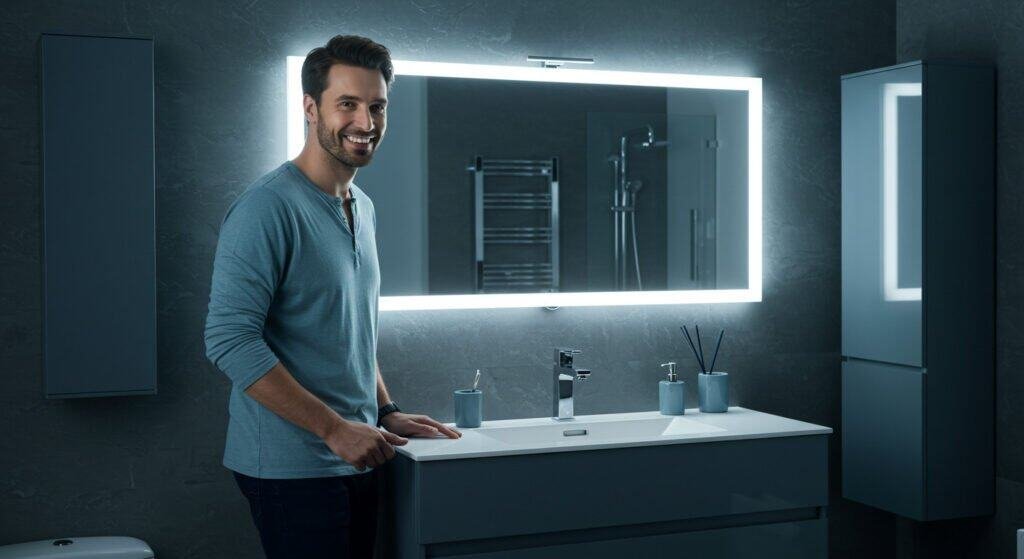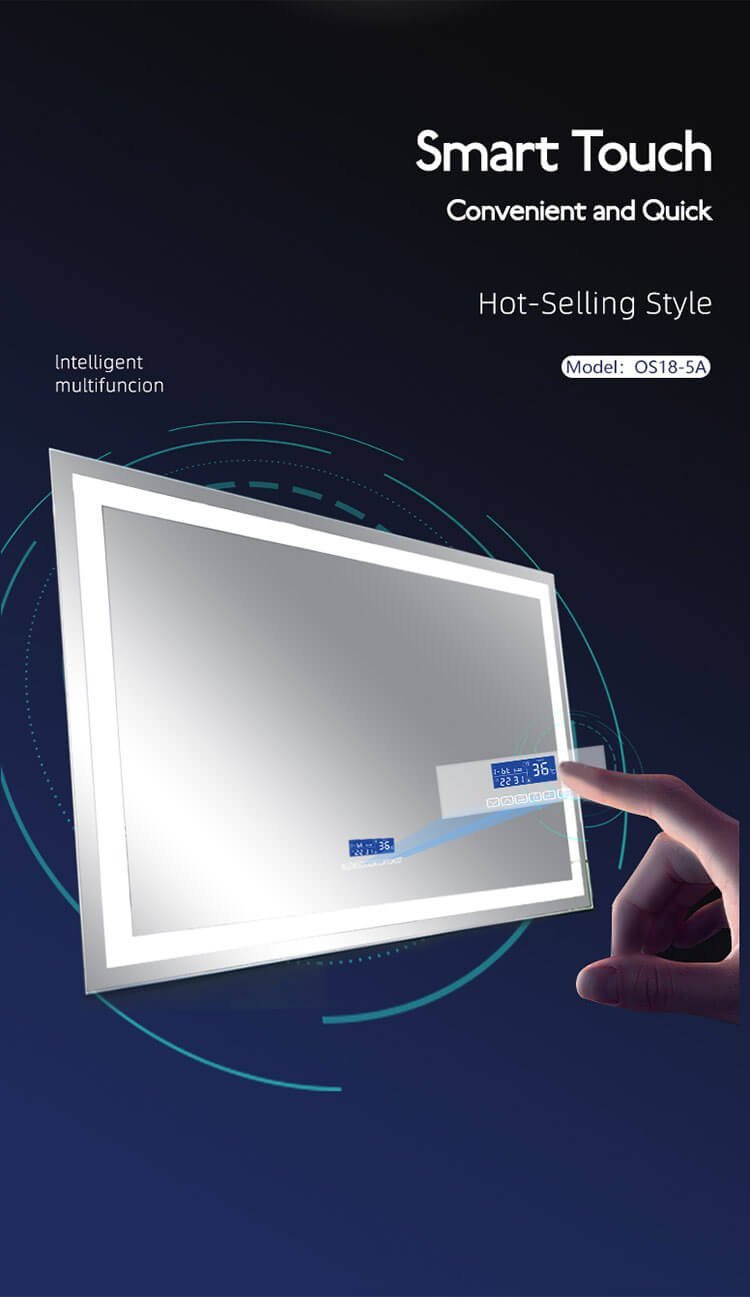Are led mirrors worth it? Traditional bathroom mirrors leave you squinting in dim lighting and struggling with fogged surfaces after every shower. Modern homeowners and businesses demand smarter, more functional solutions that enhance both aesthetics and practicality.
LED mirrors are absolutely worth the investment, offering superior illumination, energy savings up to 80% compared to traditional lighting, customizable features, and lifespans exceeding 50,000 hours while adding significant value to residential and commercial properties.
Understanding the technical specifications, cost benefits, and practical applications will help you make an informed decision about this modern lighting solution.
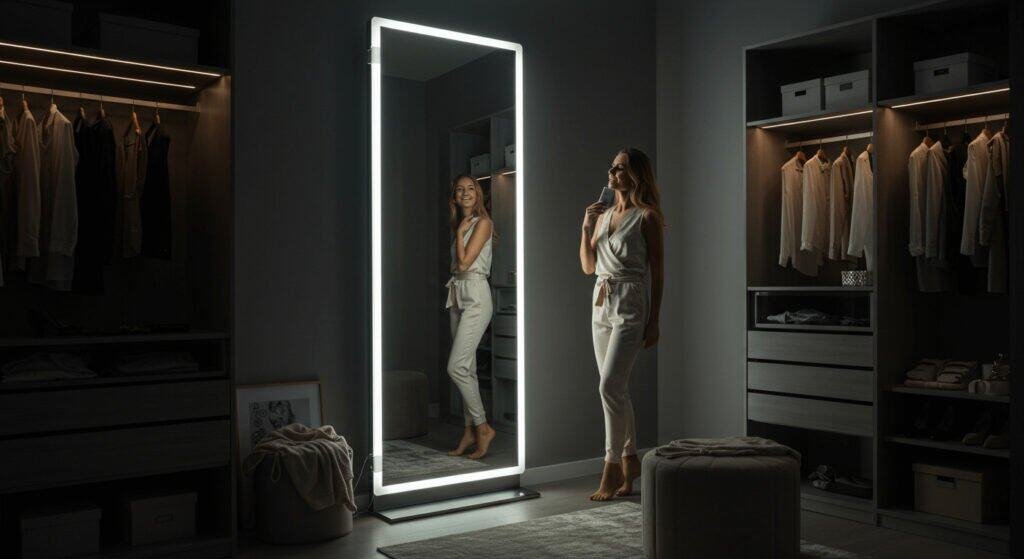
How Do LED Mirrors Work?
LED bathroom mirrors integrate energy-efficient Light Emitting Diodes directly into the mirror frame or behind the glass mirror surface. These advanced systems utilize semiconductor technology to produce consistent, high-quality illumination without generating excessive heat.
LED mirrors operate through integrated circuits that control voltage regulation, ensuring stable light output and extended component lifespan while providing instant illumination without warm-up periods.
The technical foundation involves placing LED strips or panels strategically around the mirror perimeter or behind frosted sections of the glass. Modern led mirror bathroom designs incorporate touch sensors, dimming controls, and color temperature adjustment capabilities.
The electrical components connect to standard household voltage through built-in transformers that convert power to the low-voltage requirements of LED technology. Advanced models include smart features such as motion sensors, Bluetooth connectivity, and programmable settings that respond to user preferences automatically.
What Makes LED Mirrors Different from Traditional Mirrors?
Standard bathroom mirrors require separate vanity lights or overhead lighting that creates shadows and uneven illumination. LED technology eliminates these common lighting problems while providing additional functionality that traditional mirrors cannot match.
LED bathroom mirrors combine illumination, reflection, and smart features into a single integrated unit, eliminating the need for separate lighting fixtures while providing superior light distribution and energy efficiency.
Traditional bathroom mirror setups often struggle with inadequate lighting that makes daily grooming tasks difficult. Backlit mirror technology addresses these limitations by providing even light distribution across the entire reflection surface. Unlike conventional vanity mirror with led lights arrangements that can create harsh shadows or glare, integrated LED systems offer adjustable brightness and color temperature controls.
Modern lighted mirrors for bathrooms incorporate anti-fog heating elements, digital displays for time and temperature, and connectivity features that traditional glass mirrors cannot provide. The streamlined design also eliminates the visual clutter of separate light fixtures while maximizing space efficiency in smaller bathrooms.
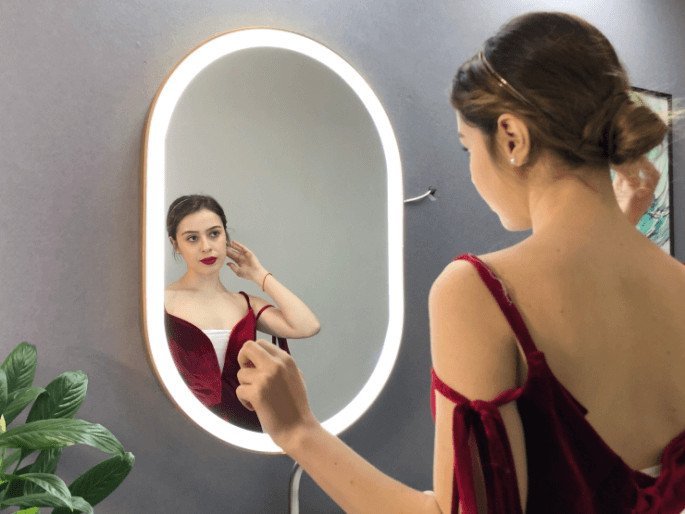
What Are the Benefits of LED Mirrors?
LED mirrors deliver multiple advantages that justify their investment cost through improved functionality, energy savings, and enhanced user experience. These benefits extend beyond basic illumination to include practical features that support daily routines.
Key benefits include 80% energy savings compared to incandescent lighting, 50,000+ hour lifespans, instant illumination, customizable color temperatures from warm to cool white, and integrated smart features such as defogging and motion sensing.
The primary advantage of led light mirror vanity systems lies in their superior energy efficiency, consuming significantly less electricity while producing brighter, more consistent illumination. Best led bathroom mirrors feature adjustable color temperature settings that range from warm 3000K for relaxing evening routines to cool 6000K for precise morning grooming tasks.
Anti-fog functionality eliminates the need to wipe mirrors after hot showers, while motion sensors provide hands-free operation that enhances convenience and hygiene. Many lighted vanity mirrors for bathroom applications include magnification zones, time displays, and ambient lighting modes that create spa-like experiences. The longevity of LED components reduces maintenance costs and replacement frequency compared to traditional bulbs.
What Are the Pros and Cons of Lighted Mirrors?
Objective evaluation of lighted mirrors requires examining both advantages and potential limitations to make informed purchasing decisions. Understanding these factors helps buyers align product capabilities with specific needs and expectations.
Lighted mirrors offer excellent illumination control, energy efficiency, and multifunctional capabilities, but require higher initial investment and professional installation while being more complex than traditional mirrors.
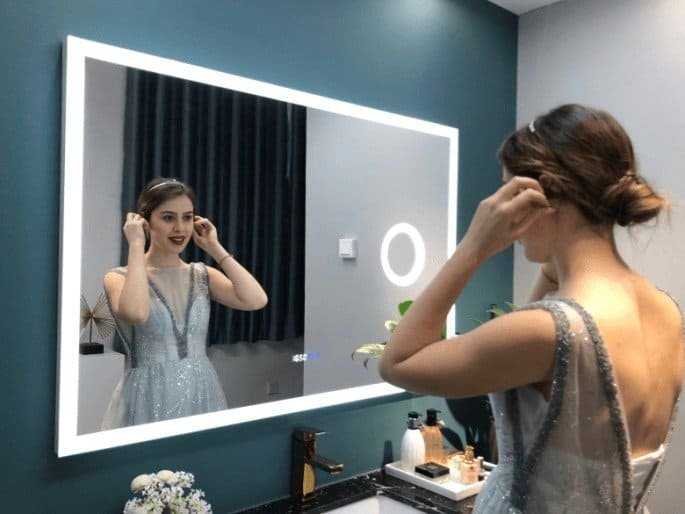
Advantages of Lighted Vanity Mirrors:
Modern lighted mirrors for bathrooms provide exceptional lighting quality that eliminates shadows and hot spots common with traditional fixture arrangements. Energy efficiency translates to lower electrical bills and reduced environmental impact over the product lifespan. The integrated design eliminates the need for separate light fixtures, creating cleaner aesthetics and maximizing space utilization. Smart features such as touch controls, automatic dimming, and programmable settings enhance user convenience significantly.
Potential Limitations:
Initial purchase costs for quality lighted bathroom mirror units exceed those of standard mirrors and separate lighting combinations. Professional installation may be required for hardwired models, adding to project expenses. Electronic components introduce complexity that could require technical support or repairs over time. Some users may prefer the simplicity and lower cost of traditional bathroom mirror and separate vanity lights configurations.
| Feature Comparison | LED Mirrors | Traditional Mirror + Separate Lights |
|---|---|---|
| Initial Cost | $200-$800 | $50-$300 |
| Energy Consumption | 15-50W | 100-300W |
| Lifespan | 50,000+ hours | 1,000-15,000 hours |
| Installation Complexity | Moderate to High | Low to Moderate |
| Space Efficiency | Excellent | Good |
| Light Distribution | Even, customizable | Variable, dependent on fixture placement |
Are LED Mirrors Accurate?
Color accuracy and reflection quality represent critical factors for applications requiring precise visual assessment, such as makeup application and professional grooming. LED mirror performance in these areas directly impacts user satisfaction and practical functionality.
High-quality LED mirrors provide excellent color accuracy with Color Rendering Index (CRI) ratings above 90, ensuring true-to-life reflection that matches natural daylight conditions for precise grooming and makeup application.
Premium lighted makeup mirror models incorporate full-spectrum LED technology that reproduces colors accurately across the visible light spectrum. The CRI measurement indicates how faithfully artificial light reveals colors compared to natural sunlight, with ratings above 90 considered excellent for detailed visual tasks.
Quality led vanity mirror units maintain consistent color temperature output throughout their operational lifespan, preventing the color shift that occurs with aging fluorescent or incandescent bulbs. Advanced models offer tunable white technology that allows users to adjust color temperature from warm to cool settings, matching ambient lighting conditions or personal preferences for different times of day.
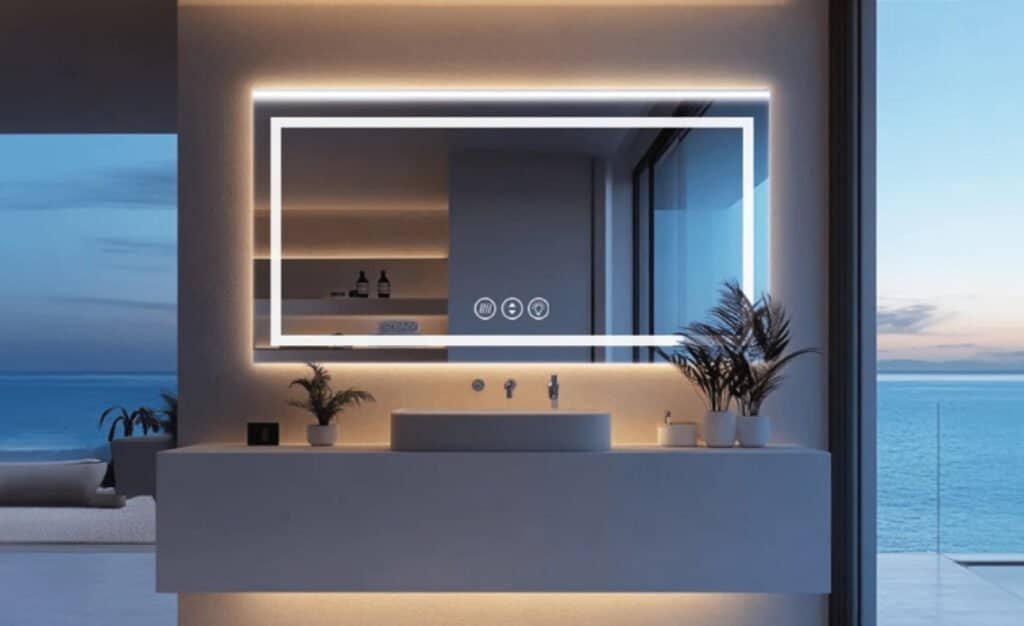
Are LED Mirrors Any Good for Different Applications?
Application suitability varies based on specific requirements, space constraints, and user expectations across residential, commercial, and hospitality environments. Understanding optimal use cases helps identify where LED mirror technology provides the greatest value.
LED mirrors excel in bathrooms, vanity areas, hotels, and commercial restrooms where consistent lighting, energy efficiency, and modern aesthetics are priorities, while providing excellent functionality for makeup application and detailed grooming tasks.
Residential Applications:
Small bathroom mirror installations benefit significantly from integrated lighting that eliminates the need for separate fixtures in space-constrained areas. Master bathroom vanity mirrors create luxurious experiences with features such as anti-fog heating, adjustable brightness, and smart controls. Lighted vanity mirrors serve makeup areas and dressing rooms where color accuracy and shadow elimination are essential for detailed personal care routines.
Commercial and Hospitality Uses:
Hotels and resorts utilize modern bathroom mirror technology to enhance guest experiences while reducing maintenance costs through LED longevity. Commercial restrooms in offices, restaurants, and retail spaces benefit from automatic sensors that improve hygiene and energy management. Wall mirror with lights configurations in fitness centers and spas provide functional illumination for grooming while supporting the premium aesthetic expectations of these environments.
How Much Do LED Mirrors Actually Cost?
Investment analysis requires examining initial purchase prices, installation costs, and long-term operational savings to determine true cost-effectiveness. Price ranges vary significantly based on size, features, and quality levels.
LED bathroom mirror prices range from $200-$800 for residential models, with premium rectangular bathroom mirrors and custom sizes reaching $1,200 or more, while energy savings of $50-$150 annually offset initial investment over time.
Initial Investment Breakdown:
Basic led mirror bathroom models in standard sizes such as led bathroom mirror 48 x 36 configurations typically cost $250-$400 for quality units with essential features. Premium options with advanced capabilities such as color temperature control, magnification zones, and smart connectivity range from $500-$800. Custom-sized units and those with specialized features such as mirrors with black frame designs or unique shapes command higher prices due to manufacturing complexity.
Long-term Cost Analysis:
Energy consumption advantages translate to measurable savings on electrical bills over the mirror lifespan. Traditional vanity lighting consuming 150-300 watts costs $100-$200 annually to operate, while LED systems using 20-50 watts reduce these expenses by 70-80%. The extended lifespan eliminates bulb replacement costs that average $30-$50 annually for traditional lighting. Professional installation costs range from $150-$400 depending on electrical requirements and complexity.
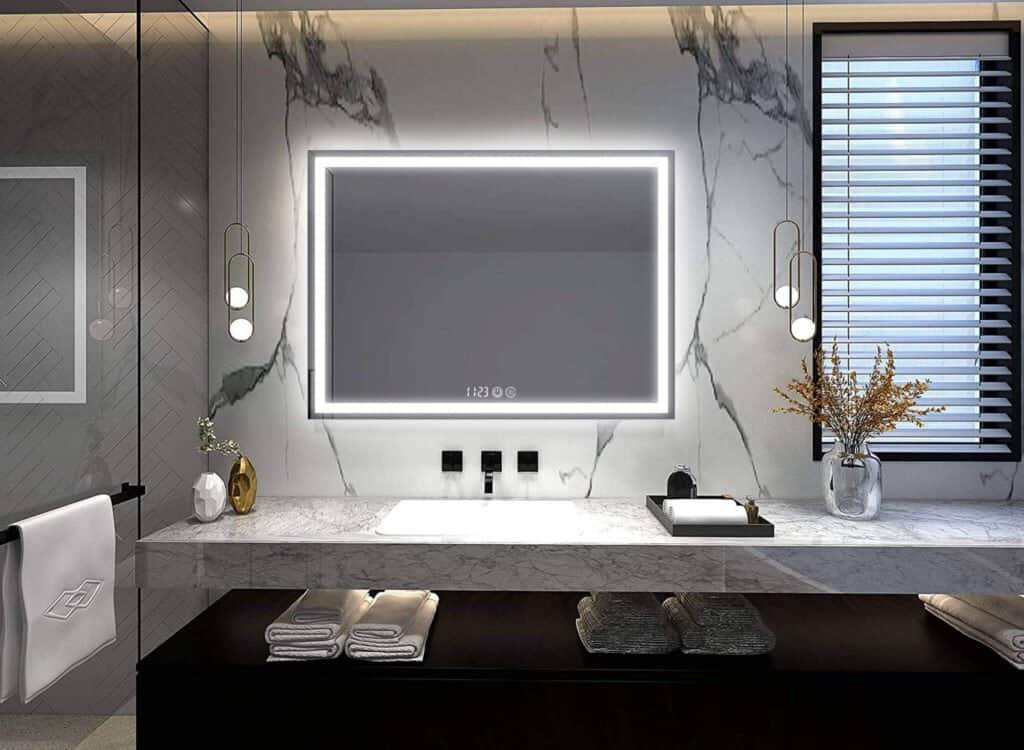
How Long Do LED Mirrors Last?
Durability and lifespan directly impact the total cost of ownership and return on investment for LED mirror purchases. Understanding expected performance periods helps buyers evaluate long-term value propositions accurately.
Quality LED mirrors typically last 50,000 to 100,000 hours of operation, equivalent to 15-25 years of normal residential use, significantly outperforming traditional lighting solutions while maintaining consistent performance throughout their lifespan.
LED Component Longevity:
The semiconductor technology underlying LED illumination provides exceptional operational stability with minimal degradation over time. Unlike incandescent bulbs that fail suddenly or fluorescent lights that dim gradually, LEDs maintain consistent light output for most of their rated lifespan before experiencing gradual reduction. Quality bathroom vanity lights integrated into mirror systems include thermal management features that prevent overheating and extend component life. Professional-grade units incorporate driver circuits with surge protection and voltage regulation that protect LED arrays from electrical fluctuations.
Maintenance Requirements:
Led bathroom mirror maintenance involves primarily surface cleaning and occasional inspection of electrical connections. The absence of replaceable bulbs eliminates the ongoing maintenance costs associated with traditional lighting systems. Electronic components such as touch sensors, dimmer controls, and smart features typically maintain functionality throughout the LED lifespan, though these elements may require service before the lighting components fail.
| Component | Expected Lifespan | Maintenance Frequency |
|---|---|---|
| LED Lights | 50,000-100,000 hours | None required |
| Touch Controls | 10-15 years | Annual inspection |
| Anti-fog Heating | 15-20 years | None required |
| Mirror Surface | 20+ years | Weekly cleaning |
| Electronic Drivers | 10-15 years | None required |
What Do Lighted Bathroom Mirrors Reviews Tell Us?
User feedback and professional evaluations provide insights into real-world performance, satisfaction levels, and common concerns that influence purchasing decisions. Review analysis reveals patterns in user experiences across different price points and feature sets.
Consumer reviews consistently praise LED mirrors for improved lighting quality, energy efficiency, and convenience features, while noting that professional installation and higher initial costs are worthwhile investments for long-term satisfaction.
Positive User Experiences:
Users frequently highlight the dramatic improvement in morning grooming routines enabled by consistent, shadow-free illumination. Anti-fog functionality receives particularly strong praise from reviewers who appreciate not having to wipe mirrors after showers. The aesthetic upgrade provided by light up vanity mirror installations earns positive comments for modernizing bathroom appearances. Energy bill reductions become apparent to users within months of installation, validating efficiency claims.
Common Concerns and Solutions:
Some reviews mention initial adjustment periods for users accustomed to traditional lighting arrangements. Installation complexity leads to professional service recommendations, though users report satisfaction with completed installations. Price sensitivity appears in reviews, though most users acknowledge the value proposition after experiencing the performance benefits. Technical features such as touch controls occasionally require familiarization periods, but users adapt quickly to the enhanced functionality.

Which Spaces Benefit Most from LED Mirrors?
Optimal applications for LED mirror technology depend on specific environmental requirements, usage patterns, and aesthetic goals. Different spaces present unique advantages for integrated lighting solutions.
Master bathrooms, powder rooms, hotel guest rooms, and commercial restrooms achieve the greatest benefits from LED mirrors due to frequent use, aesthetic importance, and energy efficiency requirements.
High-Impact Residential Applications:
Master bathroom vanity areas represent the premier application for backlit mirror technology, where daily grooming routines benefit from consistent, high-quality illumination. Guest bathrooms and powder rooms create impressive first impressions while providing practical functionality for visitors. Dressing rooms and walk-in closets utilize lighted vanity mirror configurations to support clothing selection and personal styling activities.
Commercial and Hospitality Advantages:
Hotel and resort bathrooms enhance guest experiences while reducing maintenance costs through LED longevity and reliability. Corporate restrooms benefit from automatic features that improve hygiene and energy management. Restaurant and retail restroom installations create upscale impressions while providing practical benefits for customers. Spa and fitness center applications combine functional lighting with aesthetic appeal that supports premium service positioning.
Room Mirror Ideas for Different Settings:
Small bathrooms maximize space efficiency by eliminating separate light fixtures while providing superior illumination. Modern bathroom mirror installations serve as focal points that define contemporary design aesthetics. Multiple mirror configurations in larger spaces create dramatic lighting effects while maintaining practical functionality for different users simultaneously.
Conclusion
LED mirrors represent a worthwhile investment that combines superior lighting performance, energy efficiency, and advanced functionality in a single integrated solution. The combination of reduced energy costs, extended lifespan, and enhanced user experience justifies the initial investment for most residential and commercial applications.
The evidence clearly supports LED mirror adoption for users prioritizing quality illumination, energy savings, and modern convenience features that enhance daily routines while adding long-term property value.
- Clik here to know What Is Copper Free Mirror?
- If you donot know how too choose the right bathroom height click here.
- Know more about LED bathroom mirror Problems
- Clik here to know why Touch Sensor Mirror Not Working
- Clik here to know What Are Standard Vanity Mirror Sizes?
- Clik here to know Why Are Mirrors So Expensive?
- Clik here to know Do LED Mirrors Need Electricity?
- Clik here to know Is a Lighted Mirror Enough Light for a Bathroom?
- Find out 10 Common LED Bathroom Mirror Problems Click Here

